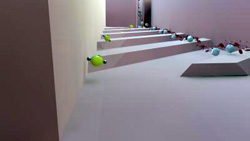Tiny 'speed bump' device could sort cancer cells

In an illustration, magnetically labeled circulating tumor cells (shown as yellow spheres) travel with red and white blood cells and platelets over an array of slanted ramps in the device. The ramps act as speed bumps, slowing the tumor cells. As the tumor cells slow, the flow carries them along the length of the ramp, causing lateral displacement. After the tumor cells traverse an array of these ramps, they have sufficiently been displaced and can be continuously isolated from other cells in the sample. Credit: Martin Rietveld<br>
In the May 25 online issue of Physical Review Letters, German Drazer, an assistant professor of chemical and biomolecular engineering, and his doctoral student, Jorge A. Bernate, reported that they have developed a lab-on-chip platform, also known as a microfluidic device, that can sort particles, cells or other tiny matter by physical means such as gravity.
By moving a liquid over a series of micron-scale high diagonal ramps — similar to speed bumps on a road — the device causes microscopic material to separate into discrete categories, based on weight, size or other factors, the team reported.
The process described in the journal article could be used to produce a medical diagnostic tool, the Whiting School of Engineering researchers say. “The ultimate goal is to develop a simple device that can be used in routine checkups by health care providers,” said doctoral student Bernate, who is lead author on the paper. “It could be used to detect the handful of circulating tumor cells that have managed to survive among billions of normal blood cells. This could save millions of lives.”
Ideally, these cancer cells in the bloodstream could be detected and targeted for treatment before they've had a chance to metastasize, or spread cancer elsewhere. Detection at early stages of cancer is critical for successful treatment.
How does this sorting process occur? Bernate explained that inside the microfluidic device, particles and cells suspended in liquid flow along a “highway” that has speed-bump-like obstacles positioned diagonally, instead of perpendicular to the path. The speed bumps differ in height, depending on the application.
“As different particles are driven over these diagonal speed bumps, heavier ones have a harder time getting over than the lighter ones,” the doctoral student said. When the particles cannot get over the ramp, they begin to change course and travel diagonally along the length of the obstacle. As the process continues, particles end up fanning out in different directions.
“After the particles cross this section of the 'highway,'” Bernate said, “they end up in different 'lanes' and can take different 'exits,' which allows for their continuous separation.”
Gravity is not the only way to slow down and sort particles as they attempt to traverse the speed bumps. “Particles with an electrical charge or that are magnetic may also find it hard to go up over the obstacles in the presence of an electric or magnetic field,” Bernate said. For example, cancer cells could be “weighted down” with magnetic beads and then sorted in a device with a magnetic field.
The ability to sort and separate things at the micro- and nanoscale is important in many industries, ranging from solar power to bio-security. But Bernate said that a medical application is likely to be the most promising immediate use for the device.
He is slated to complete his doctoral studies this summer, but until then, Bernate will continue to collaborate with researchers in the lab of Konstantinos Konstantopoulos, professor and chair of the Department of Chemical and Biomolecular Engineering, and with colleagues at InterUniversity Microelectronics Center, IMEC, in Belgium. In 2011, Bernate spent 10 weeks at IMEC in a program hosted by Johns Hopkins' Institute for NanoBioTechnology and funded by the National Science Foundation.
His doctoral adviser, Drazer, said, the research described in the new journal article eventually led Jorge down the path at IMEC to develop a device that can easily sort whole blood into its components. A provisional patent has been filed for this device.
The research by Bernate and Drazer was funded in part by the National Science Foundation and the National Institutes of Health.
Illustrations and short video available; contact Mary Spiro or Phil Sneiderman.
Related links:
German Drazer's Web page:
http://microfluidics.jhu.edu/
Department of Chemical and Biomolecular Engineering:
http://www.jhu.edu/chembe/
Note: Video at
http://youtu.be/kswk6qkVJcE
Media Contact
More Information:
http://www.jhu.eduAll latest news from the category: Life Sciences and Chemistry
Articles and reports from the Life Sciences and chemistry area deal with applied and basic research into modern biology, chemistry and human medicine.
Valuable information can be found on a range of life sciences fields including bacteriology, biochemistry, bionics, bioinformatics, biophysics, biotechnology, genetics, geobotany, human biology, marine biology, microbiology, molecular biology, cellular biology, zoology, bioinorganic chemistry, microchemistry and environmental chemistry.
Newest articles

Why getting in touch with our ‘gerbil brain’ could help machines listen better
Macquarie University researchers have debunked a 75-year-old theory about how humans determine where sounds are coming from, and it could unlock the secret to creating a next generation of more…

Attosecond core-level spectroscopy reveals real-time molecular dynamics
Chemical reactions are complex mechanisms. Many different dynamical processes are involved, affecting both the electrons and the nucleus of the present atoms. Very often the strongly coupled electron and nuclear…

Free-forming organelles help plants adapt to climate change
Scientists uncover how plants “see” shades of light, temperature. Plants’ ability to sense light and temperature, and their ability to adapt to climate change, hinges on free-forming structures in their…





















